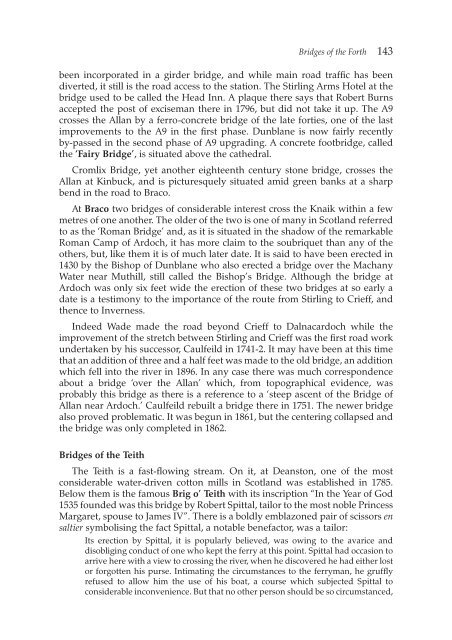the Forth Naturalist Historian - Forth Naturalist and Historian ...
the Forth Naturalist Historian - Forth Naturalist and Historian ...
the Forth Naturalist Historian - Forth Naturalist and Historian ...
Create successful ePaper yourself
Turn your PDF publications into a flip-book with our unique Google optimized e-Paper software.
Bridges of <strong>the</strong> <strong>Forth</strong> 143<br />
been incorporated in a girder bridge, <strong>and</strong> while main road traffic has been<br />
diverted, it still is <strong>the</strong> road access to <strong>the</strong> station. The Stirling Arms Hotel at <strong>the</strong><br />
bridge used to be called <strong>the</strong> Head Inn. A plaque <strong>the</strong>re says that Robert Burns<br />
accepted <strong>the</strong> post of exciseman <strong>the</strong>re in 1796, but did not take it up. The A9<br />
crosses <strong>the</strong> Allan by a ferro-concrete bridge of <strong>the</strong> late forties, one of <strong>the</strong> last<br />
improvements to <strong>the</strong> A9 in <strong>the</strong> first phase. Dunblane is now fairly recently<br />
by-passed in <strong>the</strong> second phase of A9 upgrading. A concrete footbridge, called<br />
<strong>the</strong> ‘Fairy Bridge’, is situated above <strong>the</strong> ca<strong>the</strong>dral.<br />
Cromlix Bridge, yet ano<strong>the</strong>r eighteenth century stone bridge, crosses <strong>the</strong><br />
Allan at Kinbuck, <strong>and</strong> is picturesquely situated amid green banks at a sharp<br />
bend in <strong>the</strong> road to Braco.<br />
At Braco two bridges of considerable interest cross <strong>the</strong> Knaik within a few<br />
metres of one ano<strong>the</strong>r. The older of <strong>the</strong> two is one of many in Scotl<strong>and</strong> referred<br />
to as <strong>the</strong> ‘Roman Bridge’ <strong>and</strong>, as it is situated in <strong>the</strong> shadow of <strong>the</strong> remarkable<br />
Roman Camp of Ardoch, it has more claim to <strong>the</strong> soubriquet than any of <strong>the</strong><br />
o<strong>the</strong>rs, but, like <strong>the</strong>m it is of much later date. It is said to have been erected in<br />
1430 by <strong>the</strong> Bishop of Dunblane who also erected a bridge over <strong>the</strong> Machany<br />
Water near Muthill, still called <strong>the</strong> Bishop’s Bridge. Although <strong>the</strong> bridge at<br />
Ardoch was only six feet wide <strong>the</strong> erection of <strong>the</strong>se two bridges at so early a<br />
date is a testimony to <strong>the</strong> importance of <strong>the</strong> route from Stirling to Crieff, <strong>and</strong><br />
<strong>the</strong>nce to Inverness.<br />
Indeed Wade made <strong>the</strong> road beyond Crieff to Dalnacardoch while <strong>the</strong><br />
improvement of <strong>the</strong> stretch between Stirling <strong>and</strong> Crieff was <strong>the</strong> first road work<br />
undertaken by his successor, Caulfeild in 1741-2. It may have been at this time<br />
that an addition of three <strong>and</strong> a half feet was made to <strong>the</strong> old bridge, an addition<br />
which fell into <strong>the</strong> river in 1896. In any case <strong>the</strong>re was much correspondence<br />
about a bridge ‘over <strong>the</strong> Allan’ which, from topographical evidence, was<br />
probably this bridge as <strong>the</strong>re is a reference to a ‘steep ascent of <strong>the</strong> Bridge of<br />
Allan near Ardoch.’ Caulfeild rebuilt a bridge <strong>the</strong>re in 1751. The newer bridge<br />
also proved problematic. It was begun in 1861, but <strong>the</strong> centering collapsed <strong>and</strong><br />
<strong>the</strong> bridge was only completed in 1862.<br />
Bridges of <strong>the</strong> Teith<br />
The Teith is a fast-flowing stream. On it, at Deanston, one of <strong>the</strong> most<br />
considerable water-driven cotton mills in Scotl<strong>and</strong> was established in 1785.<br />
Below <strong>the</strong>m is <strong>the</strong> famous Brig o’ Teith with its inscription “In <strong>the</strong> Year of God<br />
1535 founded was this bridge by Robert Spittal, tailor to <strong>the</strong> most noble Princess<br />
Margaret, spouse to James IV”. There is a boldly emblazoned pair of scissors en<br />
saltier symbolising <strong>the</strong> fact Spittal, a notable benefactor, was a tailor:<br />
Its erection by Spittal, it is popularly believed, was owing to <strong>the</strong> avarice <strong>and</strong><br />
disobliging conduct of one who kept <strong>the</strong> ferry at this point. Spittal had occasion to<br />
arrive here with a view to crossing <strong>the</strong> river, when he discovered he had ei<strong>the</strong>r lost<br />
or forgotten his purse. Intimating <strong>the</strong> circumstances to <strong>the</strong> ferryman, he gruffly<br />
refused to allow him <strong>the</strong> use of his boat, a course which subjected Spittal to<br />
considerable inconvenience. But that no o<strong>the</strong>r person should be so circumstanced,



